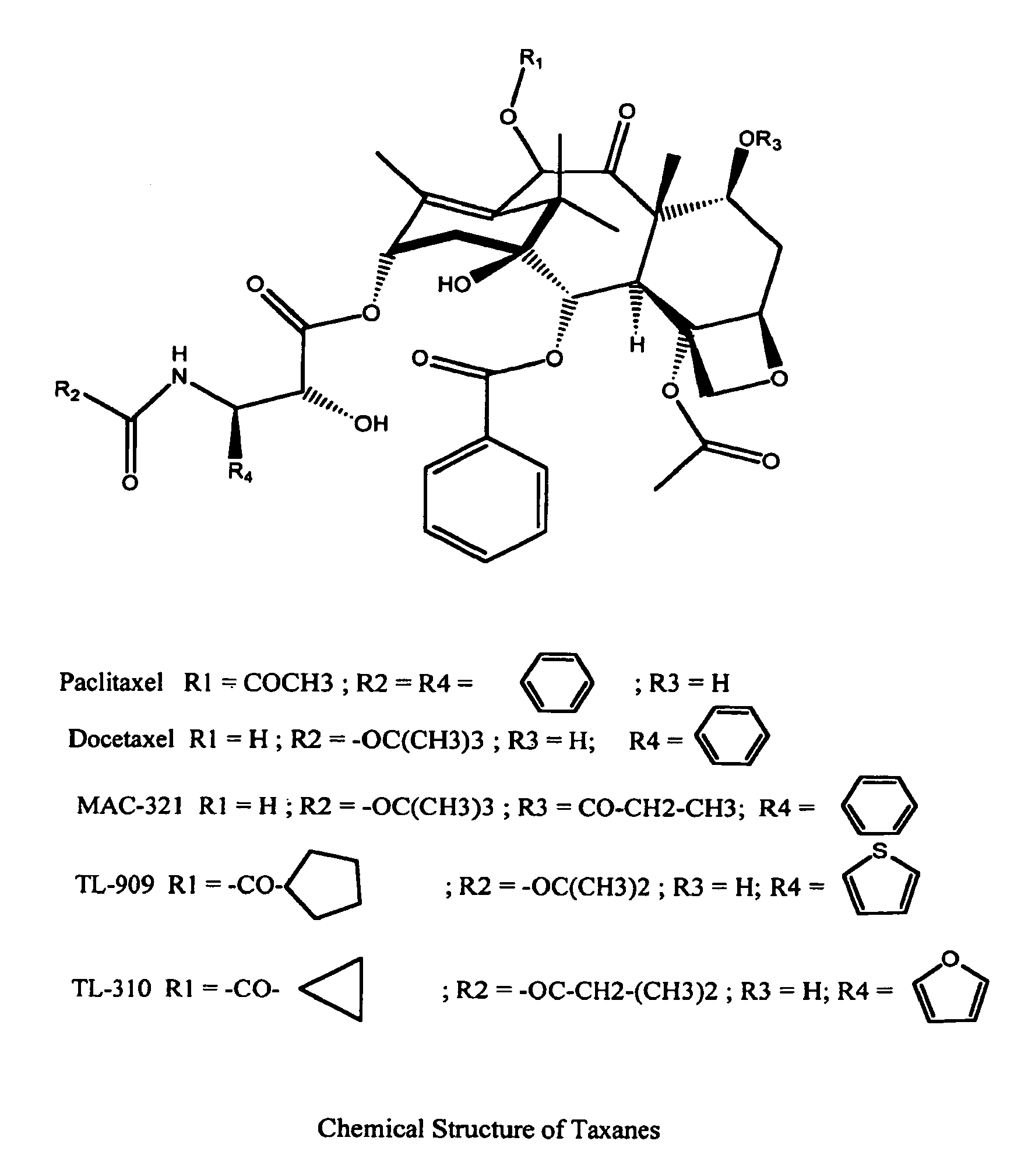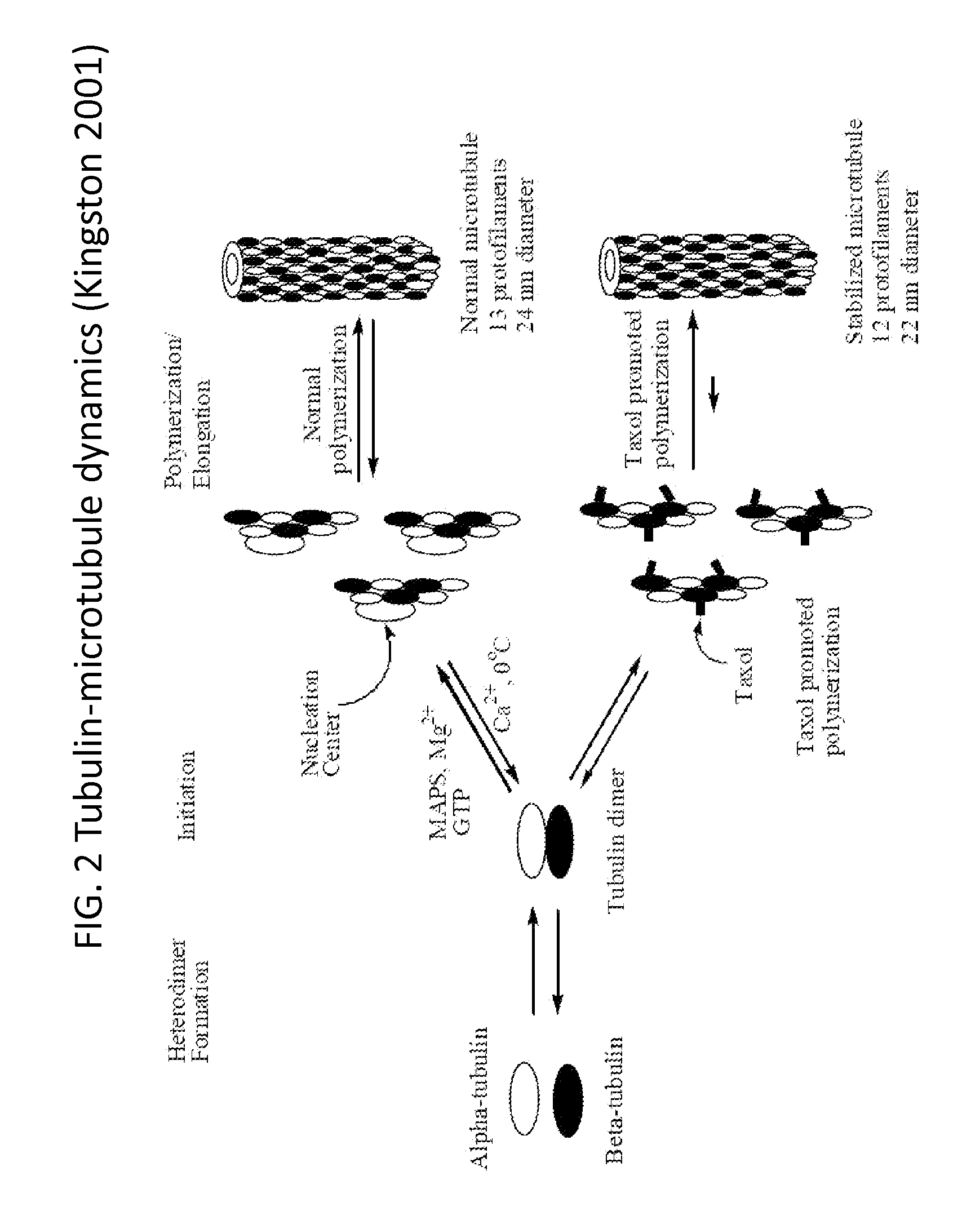Solid nanoparticle formulation of water insoluble pharmaceutical substances with reduced ostwald ripening
a technology of solid nanoparticles and pharmaceutical substances, which is applied in the direction of drug compositions, biocide, capsule delivery, etc., can solve the problems of low therapeutic index of current cancer chemotherapeutics, inability to affect tumors, and inability to be effective in vivo, and achieve the effect of stable dispersions of solid particles
- Summary
- Abstract
- Description
- Claims
- Application Information
AI Technical Summary
Benefits of technology
Problems solved by technology
Method used
Image
Examples
example 1
Preparation of Unstable Solid Nanoparticle with Cholesterol as Inhibitor
[0156]A mixture of 96 mg of cholesterol and 100 mg of docetaxel (Guiyuanchempharm, China) were dissolved in 2.5 mL of chloroform and 0.5 mL of ethanol mixture. A 3% human albumin solution was prepared by dissolving 1.5 gms of human albumin (Sigma-Aldrich Co, USA) in 50 mL of sterile Type I water. The pH of the human albumin solution was adjusted to 6.0-6.8 by adding either 1N hydrochloric acid or 1N sodium hydroxide solution in sterile water. The above organic solution was added to the albumin phase and the mixture was pre-homogenized with a IKA homogenizer at 4000-6000 RPM (IKA Works, Germany). The resulting emulsion was subjected to high-pressure homogenization (Avestin Inc, USA). The pressure was varied between 15,000 and 20,000 psi and the emulsification process was continued for 5-8 passes. During homogenization the emulsion was cooled between 5° C. and 10° C. by circulating the coolant through the homogeni...
example 2
Preparation of Stable Solid Nanoparticle with Cholesterol and Cholesteryl Stearate as Inhibitors
[0158]A mixture of 100 mg of cholesterol (Northern Lipids, Canada), 500 mg of cholesteryl stearate (Sigma Aldrich, Mo) and 100 mg of docetaxel (Guiyuanchempharm, China) were dissolved in 2.5 mL of chloroform and 0.5 mL of ethanol mixture. A 5% human albumin solution was prepared by dissolving 2.5 gms of human albumin (Sigma-Aldrich Co, USA) in 50 mL of sterile Type I water. The pH of the human albumin solution was adjusted to 6.0-6.8 by adding either 1N hydrochloric acid or 1N sodium hydroxide solution in sterile water. The above organic solution was added to the albumin phase and the mixture was pre-homogenized with a IKA homogenizer at 4000-6000 RPM (IKA Works, Germany). The resulting emulsion was subjected to high-pressure homogenization (Avestin Inc, USA). The pressure was varied between 15,000 and 20,000 psi and the emulsification process was continued for 5-8 passes. During homogeni...
example 3
Preparation of Stable Solid Nanoparticle with Cholesterol and Cholesteryl Stearate as Inhibitors
[0160]A mixture of 50 mg of cholesterol (Northern Lipids, Canada), 250 mg of cholesteryl stearate (Sigma Aldrich, Mo) and 100 mg of docetaxel (Guiyuanchempharm, China) were dissolved in 2.5 mL of chloroform and 0.5 mL of ethanol mixture. A 5% human albumin solution was prepared by dissolving 2.5 gms of human albumin (Sigma-Aldrich Co, USA) in 50 mL of sterile Type I water. The pH of the human albumin solution was adjusted to 6.0-6.8 by adding either 1N hydrochloric acid or 1N sodium hydroxide solution in sterile water. The above organic solution was added to the albumin phase and the mixture was pre-homogenized with a IKA homogenizer at 4000-6000 RPM (IKA Works, Germany). The resulting emulsion was subjected to high-pressure homogenization (Avestin Inc, USA). The pressure was varied between 15,000 and 20,000 psi and the emulsification process was continued for 5-8 passes. During homogeniz...
PUM
| Property | Measurement | Unit |
|---|---|---|
| mean particle size | aaaaa | aaaaa |
| particle size | aaaaa | aaaaa |
| particle size | aaaaa | aaaaa |
Abstract
Description
Claims
Application Information
 Login to View More
Login to View More - R&D
- Intellectual Property
- Life Sciences
- Materials
- Tech Scout
- Unparalleled Data Quality
- Higher Quality Content
- 60% Fewer Hallucinations
Browse by: Latest US Patents, China's latest patents, Technical Efficacy Thesaurus, Application Domain, Technology Topic, Popular Technical Reports.
© 2025 PatSnap. All rights reserved.Legal|Privacy policy|Modern Slavery Act Transparency Statement|Sitemap|About US| Contact US: help@patsnap.com



